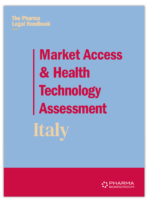Italy,
September 2022
At a crucial moment ahead of a snap general election on 25 September 2022, this new report looks back at the progress that Italy’s healthcare and life sciences sector has made in recent years and assesses its future prospects.
While the country’s political winds are difficult to predict, Italy’s place at the top table of European life sciences today is inarguable and nowhere was this better displayed than in the country’s bounce-back from the COVID-19 pandemic.
Despite the unprecedented strain of the pandemic hitting Italy harder than many of its European peers, the Italian life sciences sector held its ground as one of the drivers of a resurgent national economy, generating EUR 34.4 billion in production in 2021.
With the third-largest population in the EU after Germany and France and a life expectancy averaging at 83 years, one of the highest in the world, Italy represents an attractive market for international pharma. Moreover, the country has a host of its own homegrown industry champions, known for their endurance and entrepreneurial prowess.
With over 200 medicine and vaccine manufacturers, the Italian nation has established itself as a European production powerhouse with 74 percent growth in medicine exports between 2015- 2020. In addition, Italy, home of world-renowned scientific expertise, saw EUR 1.7 billion in R&D investments last year.
However, the Italian life sciences market is not without its frailties. Despite its many attributes, the country has a reputation for chronic underfunding, complex regulatory roadmaps, and a lower price point for reimbursed drugs.
The funds from the European Union for the National Recovery and Resilience Plan (NRRP), of which EUR 18.5 billion have been allocated to healthcare, may provide the necessary momentum to resolve these issues, yet with the recent resignation of premier Mario Draghi political instability now looms in Italy’s near future.
Through in-depth interviews with key stakeholders across the Italian healthcare value chain – including the CEOs of leading Italian companies, government authorities, heads of the local affiliates of multinational pharma companies, and representatives from the medtech and biotech industries –, this report provides a comprehensive look at where Italy’s healthcare and life sciences ecosystem stands today.
At a crucial moment ahead of a snap general election on 25 September 2022, this new report looks back at the progress that Italy’s healthcare and life sciences sector has made in recent years and assesses its future prospects.
While the country’s political winds are difficult to predict, Italy’s place at the top table of European life sciences today is inarguable and nowhere was this better displayed than in the country’s bounce-back from the COVID-19 pandemic.
Despite the unprecedented strain of the pandemic hitting Italy harder than many of its European peers, the Italian life sciences sector held its ground as one of the drivers of a resurgent national economy, generating EUR 34.4 billion in production in 2021.
With the third-largest population in the EU after Germany and France and a life expectancy averaging at 83 years, one of the highest in the world, Italy represents an attractive market for international pharma. Moreover, the country has a host of its own homegrown industry champions, known for their endurance and entrepreneurial prowess.
With over 200 medicine and vaccine manufacturers, the Italian nation has established itself as a European production powerhouse with 74 percent growth in medicine exports between 2015- 2020. In addition, Italy, home of world-renowned scientific expertise, saw EUR 1.7 billion in R&D investments last year.
However, the Italian life sciences market is not without its frailties. Despite its many attributes, the country has a reputation for chronic underfunding, complex regulatory roadmaps, and a lower price point for reimbursed drugs.
The funds from the European Union for the National Recovery and Resilience Plan (NRRP), of which EUR 18.5 billion have been allocated to healthcare, may provide the necessary momentum to resolve these issues, yet with the recent resignation of premier Mario Draghi political instability now looms in Italy’s near future.
Through in-depth interviews with key stakeholders across the Italian healthcare value chain – including the CEOs of leading Italian companies, government authorities, heads of the local affiliates of multinational pharma companies, and representatives from the medtech and biotech industries –, this report provides a comprehensive look at where Italy’s healthcare and life sciences ecosystem stands today.
See more
























